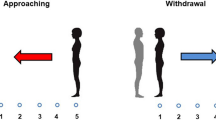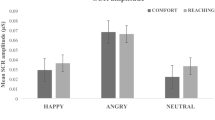Abstract
The amygdala plays key roles in emotion and social cognition, but how this translates to face-to-face interactions involving real people remains unknown. We found that an individual with complete amygdala lesions lacked any sense of personal space. Furthermore, healthy individuals showed amygdala activation upon close personal proximity. The amygdala may be required to trigger the strong emotional reactions normally following personal space violations, thus regulating interpersonal distance in humans.
This is a preview of subscription content, access via your institution
Access options
Subscribe to this journal
Receive 12 print issues and online access
$209.00 per year
only $17.42 per issue
Buy this article
- Purchase on Springer Link
- Instant access to full article PDF
Prices may be subject to local taxes which are calculated during checkout


Similar content being viewed by others
References
Hall, E. The Hidden Dimension (Doubleday, Garden City, New York, USA, 1966).
Hayduk, L.A. Psychol. Bull. 85, 117–134 (1978).
Kluver, H. & Bucy, P.C. Am. J. Physiol. 119, 352–353 (1937).
Emery, N.J. et al. Behav. Neurosci. 115, 515–544 (2001).
Mason, W.A., Capitanio, J.P., Machado, C.J., Mendoza, S.P. & Amaral, D.G. Emotion 6, 73–81 (2006).
Adolphs, R., Tranel, D. & Damasio, A.R. Nature 393, 470–474 (1998).
Buchanan, T.W., Tranel, D. & Adolphs, R. in The Human Amygdala (eds. Whalen, P.J. & Phelps, E.A.) 289–320 (Oxford Univ. Press, New York, 2009).
Couzin, I.D., Krause, J., James, R., Ruxton, G.D. & Franks, N.R. J. Theor. Biol. 218, 1–11 (2002).
Couzin, I.D., Krause, J., Franks, N.R. & Levin, S.A. Nature 433, 513–516 (2005).
Hayduk, L.A. Psychol. Bull. 94, 293–335 (1983).
Pezawas, L. et al. Nat. Neurosci. 8, 828–834 (2005).
Acknowledgements
We thank C. Holcomb for behavioral data collection, R. Nair and V. Chib for help with the fMRI study, and M. Spezio for discussions. Supported by US National Institute of Mental Health and the Simons Foundation (R.A.), the Della Martin Foundation (D.P.K.) and the Tamagawa University global Centers of Excellence program of the Japanese Ministry of Education, Culture, Sports and Technology.
Author information
Authors and Affiliations
Contributions
D.P.K. and R.A. designed the experiment and wrote the paper; D.P.K. executed the studies; D.P.K., J.G. and J.M.T. analyzed the data.
Corresponding author
Supplementary information
Supplementary Text and Figures
Supplementary Text (PDF 134 kb)
Rights and permissions
About this article
Cite this article
Kennedy, D., Gläscher, J., Tyszka, J. et al. Personal space regulation by the human amygdala. Nat Neurosci 12, 1226–1227 (2009). https://doi.org/10.1038/nn.2381
Received:
Accepted:
Published:
Issue Date:
DOI: https://doi.org/10.1038/nn.2381
This article is cited by
-
The relationship between action, social and multisensory spaces
Scientific Reports (2023)
-
Simulated proximity enhances perceptual and physiological responses to emotional facial expressions
Scientific Reports (2022)
-
Amygdala–pons connectivity is hyperactive and associated with symptom severity in depression
Communications Biology (2022)
-
No faces, just body movements—Effects of perceived emotional valence of body kinetics and psychological factors on interpersonal distance behavior within an immersive virtual environment
Current Psychology (2022)
-
The physiological correlates of interpersonal space
Scientific Reports (2021)



